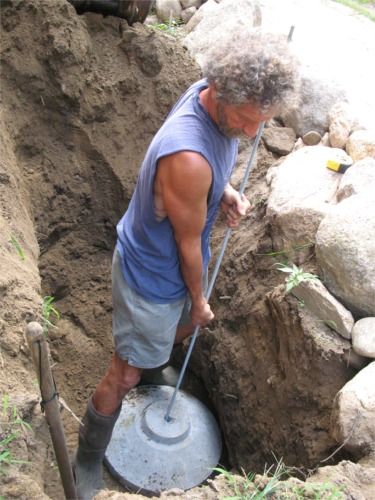Precast Footings: EZ-Tube
These stackable manufactured concrete piers are one option if you care more about saving time than saving money.

Last fall my local lumberyard began stocking EZ-Tube from EZ-CRETE. The display was intriguing – a simple stack of precast concrete sections tied together with a galvanized rod. I gave the system a try this summer on a small deck to see how easy they install and determine whether they’re cost effective when compared to formed and poured footings.

Ease of Installation
Dig the hole, drop in the sections, backfill – you’re ready to build.
There’s no getting around digging and backfilling the footing holes whether pouring in place or using EZ-Tube; the only difference is that you need to level off the bottom of the hole for the EZ-Tube base so the sections stack up plumb.
Once the hole was prepped I inserted the galvanized rod through the base section and held onto the rod to lower base into the hole. The base weighs a manageable 80 lbs. +/-.

There is some play in the stack of sections so I periodically checked when backfilling to make sure the tops remained in the right locations. Had a base been a little off, this play would have enabled me to shift stack an inch or two in any direction to dial it in. And since the connecting rod doubles as the anchor for the post base, it is important to orient the top right where you want it.
It takes just a little longer to place the EZ-Tubes as it would to set footing forms for cast-in-place footings.
Cost Comparison – Cast-in-place vs. EZ-Tube
- Digging and backfilling – same for both.
- EZ-Tube: $187 / footing
- 4 EZ-Footing sections, 1 base and galvanized rod = $157
- Labor: 30 minutes (move and place the sections) = $30
- Cast In Place: $138 / footing
- 12 in. Footing form, 1 plastic footing base form, rebar, concrete and anchor bolt = $48
- Labor: 1 hour 30 minutes (mobilize equipment, move materials, place forms, mix and place concrete) = $90
Other Considerations – Why you may want to use EZ-Tube:
- It’s freezing outside and you have to set footings.
- There’s no water on the jobsite so you’ll have to haul some to mix concrete and clean tools.
- You don’t want to wait a day or two to begin building on poured-in-place footings.
- Rain in the forecast – will the cardboard footing tubes collapse or the formed footing hole get swamped waiting for an inspection? And no need to worry about that pallet of concrete sacks getting wet. A pallet of EZ-Tubes doesn’t need to be covered.
- In some jurisdictions you have to wait several days for an inspection. That could delay deck construction with conventional footings. I can imagine setting EZ-Tubes and not backfilling until after the deck is framed – then getting one inspection for both footings and framing at once.
Availability – Limited
Right now EZ-Tubes are only stocked at some building material dealers in NJ, NY and New England states. The makers hope to expand distribution.
Load Capacity
The footings themselves can handle anything you throw at them. The limiting factor will be the soil beneath. Here are quick calcs. for the 22 in. diameter base and the 12 in. section using the load bearing listed in the 2015 IRC.
| Soil Capacity | 22 inch base | 12 inch section |
| 1500 psf | 3960 lbs | 1178 lbs |
| 2000 psf | 5280 lbs | 1571 lbs |
| 3000 psf | 7919 lbs | 2356 lbs |
| 4000 psf | 10559 lbs | 3142 lbs |









View Comments
Are they IRC code approved?
How do they resist frost action?
This is genius!
REPLY to RCTINC
"Are they IRC code approved?" They don't need to be 'code approved' Only alternative building systems need an ICC-ESR. Since precast footings (like EZ-Tube) are equivalent to poured-in-place footings they fall under the prescriptive measures of the IRC. So they are qualified as far as I see it.
The company has engineering data if you find a building official who expresses concern.
"How do they resist frost action" - provided you dig the hole deep enough and place the EZ-Tube below frost depth, you're all set. That's one thing I like about the system. If you're in VA with a frost depth of 16 in. you just need a base and 1 section. If you're in ME with a 4 ft frost depth, you stack up 4 sections on top of the base.
Nicely done.. Awesome